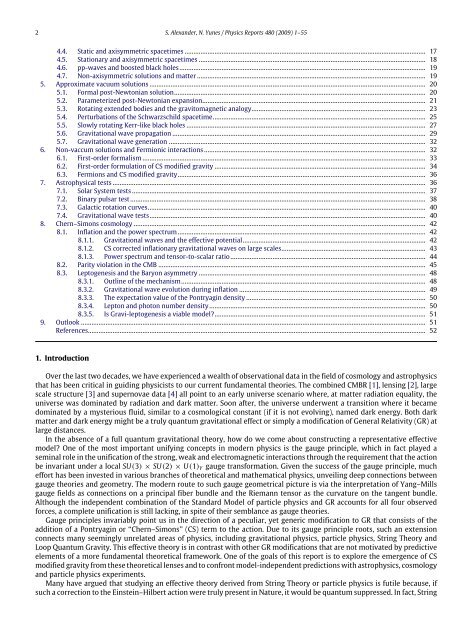Physics Reports ChernâSimons modified general relativity
Physics Reports ChernâSimons modified general relativity
Physics Reports ChernâSimons modified general relativity
You also want an ePaper? Increase the reach of your titles
YUMPU automatically turns print PDFs into web optimized ePapers that Google loves.
2 S. Alexander, N. Yunes / <strong>Physics</strong> <strong>Reports</strong> 480 (2009) 1–554.4. Static and axisymmetric spacetimes ......................................................................................................................................... 174.5. Stationary and axisymmetric spacetimes ................................................................................................................................. 184.6. pp-waves and boosted black holes ............................................................................................................................................ 194.7. Non-axisymmetric solutions and matter .................................................................................................................................. 195. Approximate vacuum solutions ............................................................................................................................................................. 205.1. Formal post-Newtonian solution............................................................................................................................................... 205.2. Parameterized post-Newtonian expansion............................................................................................................................... 215.3. Rotating extended bodies and the gravitomagnetic analogy................................................................................................... 235.4. Perturbations of the Schwarzschild spacetime......................................................................................................................... 255.5. Slowly rotating Kerr-like black holes ........................................................................................................................................ 275.6. Gravitational wave propagation ................................................................................................................................................ 295.7. Gravitational wave generation .................................................................................................................................................. 326. Non-vaccum solutions and Fermionic interactions .............................................................................................................................. 326.1. First-order formalism ................................................................................................................................................................. 336.2. First-order formulation of CS <strong>modified</strong> gravity ........................................................................................................................ 346.3. Fermions and CS <strong>modified</strong> gravity............................................................................................................................................. 367. Astrophysical tests .................................................................................................................................................................................. 367.1. Solar System tests ....................................................................................................................................................................... 377.2. Binary pulsar test ........................................................................................................................................................................ 387.3. Galactic rotation curves.............................................................................................................................................................. 407.4. Gravitational wave tests............................................................................................................................................................. 408. Chern–Simons cosmology ...................................................................................................................................................................... 428.1. Inflation and the power spectrum ............................................................................................................................................. 428.1.1. Gravitational waves and the effective potential........................................................................................................ 428.1.2. CS corrected inflationary gravitational waves on large scales.................................................................................. 438.1.3. Power spectrum and tensor-to-scalar ratio ............................................................................................................... 448.2. Parity violation in the CMB ........................................................................................................................................................ 458.3. Leptogenesis and the Baryon asymmetry ................................................................................................................................. 488.3.1. Outline of the mechanism........................................................................................................................................... 488.3.2. Gravitational wave evolution during inflation .......................................................................................................... 498.3.3. The expectation value of the Pontryagin density ...................................................................................................... 508.3.4. Lepton and photon number density ........................................................................................................................... 508.3.5. Is Gravi-leptogenesis a viable model?........................................................................................................................ 519. Outlook .................................................................................................................................................................................................... 51References................................................................................................................................................................................................ 521. IntroductionOver the last two decades, we have experienced a wealth of observational data in the field of cosmology and astrophysicsthat has been critical in guiding physicists to our current fundamental theories. The combined CMBR [1], lensing [2], largescale structure [3] and supernovae data [4] all point to an early universe scenario where, at matter radiation equality, theuniverse was dominated by radiation and dark matter. Soon after, the universe underwent a transition where it becamedominated by a mysterious fluid, similar to a cosmological constant (if it is not evolving), named dark energy. Both darkmatter and dark energy might be a truly quantum gravitational effect or simply a modification of General Relativity (GR) atlarge distances.In the absence of a full quantum gravitational theory, how do we come about constructing a representative effectivemodel? One of the most important unifying concepts in modern physics is the gauge principle, which in fact played aseminal role in the unification of the strong, weak and electromagnetic interactions through the requirement that the actionbe invariant under a local SU(3) × SU(2) × U(1) Y gauge transformation. Given the success of the gauge principle, mucheffort has been invested in various branches of theoretical and mathematical physics, unveiling deep connections betweengauge theories and geometry. The modern route to such gauge geometrical picture is via the interpretation of Yang–Millsgauge fields as connections on a principal fiber bundle and the Riemann tensor as the curvature on the tangent bundle.Although the independent combination of the Standard Model of particle physics and GR accounts for all four observedforces, a complete unification is still lacking, in spite of their semblance as gauge theories.Gauge principles invariably point us in the direction of a peculiar, yet generic modification to GR that consists of theaddition of a Pontryagin or ‘‘Chern–Simons’’ (CS) term to the action. Due to its gauge principle roots, such an extensionconnects many seemingly unrelated areas of physics, including gravitational physics, particle physics, String Theory andLoop Quantum Gravity. This effective theory is in contrast with other GR modifications that are not motivated by predictiveelements of a more fundamental theoretical framework. One of the goals of this report is to explore the emergence of CS<strong>modified</strong> gravity from these theoretical lenses and to confront model-independent predictions with astrophysics, cosmologyand particle physics experiments.Many have argued that studying an effective theory derived from String Theory or particle physics is futile because, ifsuch a correction to the Einstein–Hilbert action were truly present in Nature, it would be quantum suppressed. In fact, String



![arXiv:1001.0993v1 [hep-ph] 6 Jan 2010](https://img.yumpu.com/51282177/1/190x245/arxiv10010993v1-hep-ph-6-jan-2010.jpg?quality=85)


![arXiv:1008.3907v2 [astro-ph.CO] 1 Nov 2011](https://img.yumpu.com/48909562/1/190x245/arxiv10083907v2-astro-phco-1-nov-2011.jpg?quality=85)







![arXiv:1002.4928v1 [gr-qc] 26 Feb 2010](https://img.yumpu.com/41209516/1/190x245/arxiv10024928v1-gr-qc-26-feb-2010.jpg?quality=85)
![arXiv:1206.2653v1 [astro-ph.CO] 12 Jun 2012](https://img.yumpu.com/39510078/1/190x245/arxiv12062653v1-astro-phco-12-jun-2012.jpg?quality=85)
